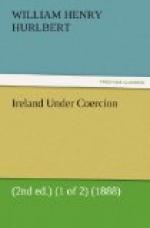An Expense Book, too, of the great Marquis, after he became the first Duke of Ormonde, Colonel Blood’s Duke, kept at Kilkenny in 1668 throws some interesting light on the cost of living and the customs of great houses at that time. The Duke, who was in some respects the greatest personage in the realm, kept up his state here at a weekly cost of about L50, a good deal less—allowing for the fall in the power of the pound sterling—than it would now cost him to live at a fashionable London hotel. He paid L9, 10s. a week for the keep of nineteen horses, 18 shillings board wages for three laundry-maids, and L1, 17s. 4d. for seven dozen of tallow-candles. The wines served at the ducal table were Burgundy, Bordeaux, “Shampane,” Canary, “Renish,” and Portaport, the last named at a shilling a bottle, while he paid no more than L3, 18s. for six dozen bottles of Bordeaux, and L1, 1s. for a dozen and a half of “Shampane.” This of course was not the sparkling beverage which in our times is the only contribution of Champagne to the wine markets of the world, for the Ay Mousseux first appears in history at the beginning of the eighteenth century. It was the red wine of Champagne, which so long contested the palm with the vintages of Burgundy. St. Evremond, who with the Comte d’Olonne and the great gourmets of the seventeenth century thought Champagne the best, as the Faculty of Paris also pronounced it the most wholesome of wines, doubtless introduced his own religion on the subject into England—but the entry in the Duke’s Expense Book of 1668 is an interesting proof that the duel of the vintages was even then going as it finally went in favour of Burgundy. While the Duke got his Champagne for 1s. 2d. a bottle, he had to pay twenty shillings a dozen, or 1s. 8d. a bottle, for five dozen of Burgundy. He got his wines from Dublin, which then, as long before, was the most noted wine mart of Britain. The English princes drew their best supplies thence in the time of Richard II.
From the castle we drove through the snow to the Cathedral of St. Canice, a grand and simple Norman edifice of the twelfth century, now the Church of the Protestant bishop. An ancient Round Tower of much earlier date stands beside it like a campanile, nearly a hundred feet in height.
There is a legend that Rinuccini wanted to buy and carry away one of the great windows of this Cathedral, in which mass was celebrated while he was here. The Cathedral contains some interesting monuments of the Butlers, and there are many curiously channelled burial slabs in the floor, like some still preserved in the ruins of Abbeyleix. Lord de Vesci pointed out to me several tombs of families of English origin once powerful here, but now sunk into the farmer class. On one of these I think it was that we saw a remarkably well-preserved effigy of a lady, wearing a plaited cap under a “Waterford cloak”—one of the neatest varieties of the Irish women’s cloak—garment so picturesque at once, and




